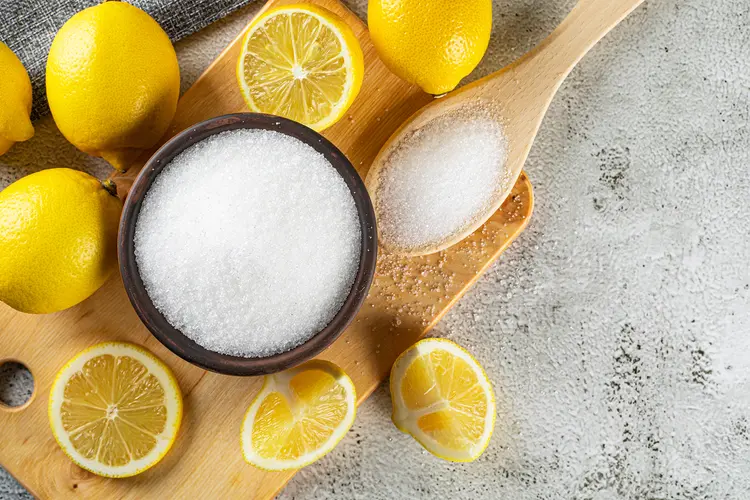Citric acid (C₆H₈O₇) is a tricarboxylic acid that occurs naturally in citrus fruits. It ranks among the most widely used food additives and industrial chemicals in modern applications. First isolated from lemon juice by Carl Wilhelm Scheele in 1784, citric acid has become essential for pH control, flavor enhancement, and preservation.
- Chemical Formula: C₆H₈O₇
- Molecular Weight: 192.13 g/mol
- Appearance: White crystalline powder
- Solubility: Highly soluble in water and ethanol
- Taste: Tart or sour

Types and Forms of Citric Acid
Citric acid is commercially available in the following forms:
Anhydrous Citric Acid
Water-free citric acid is used in tablets, powdered drinks, and cosmetics. It appears as fine white crystals or powder and dissolves quickly, making it ideal for dry formulations.
| Pros | Cons |
| √ Dissolves quickly in water | × Can absorb moisture if not stored well |
| √ Has a longer shelf life than monohydrate | × May cost slightly more |
| √ No water content – good for dry mixes | × Can be irritating to skin or eyes in dust |
| √ Works well in powdered products | × Not ideal for products needing slow release |
| √ Stable in storage when kept dry |
Monohydrate Citric Acid
Citric acid monohydrate has one water molecule, widely used in food, beverages, and syrups. It features slightly larger crystals compared to the anhydrous form, ideal for wet formulations.
| Pros | Cons |
| √ Easy to dissolve in water | × Less stable in very humid places |
| √ Common in food and drink products | × Slightly heavier than anhydrous type |
| √ Works well for pH control and taste | × Not ideal for dry powder mixes |
| √ Good for making syrups and liquids | |
| √ Widely available and affordable |
Liquid Citric Acid
Liquid citric acid is an aqueous solution ideal for easy blending, commonly used in industrial cleaners, descaling agents, and cosmetic formulations for pH control.
| Pros | Cons |
| √ Easy to mix into liquids | × Heavier and harder to transport |
| √ No need to dissolve powder | × Shorter shelf life than powder |
| √ Good for fast production lines | × Can freeze or spoil if stored poorly |
| √ Perfect for cleaning and pH control | × Needs careful handling and storage |
| √ Ready to use |

How is Citric Acid Made?
Citric acid comes from either natural or synthetic production sources.
Fermentation Process (Microbial Synthesis)
- Most common production method today
- Glucose or molasses is fermented using Aspergillus niger (a type of mold)
- Environmentally sustainable and cost-effective
Extraction from Citrus Fruits
- Traditional method, now rarely used due to high cost
- Extracted from lemons, limes, and oranges
Chemical Synthesis (Rare)
- Involves reaction of glycerol or other organic precursors
- Economically and environmentally less favorable
Applications of Citric Acid
Citric acid is a highly versatile organic acid used widely in food, pharma, cosmetics, and cleaning industries.
Food and Beverage Industry
- As an acidulant: Enhances sour flavor in candies, soft drinks, and preserves
- As a preservative: Inhibits microbial growth by lowering pH
- As a chelating agent: Enhances product stability and longevity.
Pharmaceuticals and Healthcare
- Effervescent tablets: Combines with bicarbonates to produce fizz
- Buffering agent: Controls pH in medicinal syrups and solutions
- Chelator: Binds with metals in blood detox and IV fluids
Cosmetics and Personal Care
- pH balancer: Adjusts acidity in creams, shampoos, and lotions
- Preservative booster: Enhances product longevity and safety
- Skin exfoliator: In alpha-hydroxy acid (AHA) formulations
Cleaning and Detergents
- Descaler: Removes limescale from kettles, dishwashers, and washing machines
- Stain remover: Effective against hard water marks and soap scum
- Eco-friendly alternative: Biodegradable and safer than phosphates
Industrial and Technical Uses
- Metal cleaning: Chelates calcium, magnesium, and iron ions
- Electroplating and textile processing: Controls pH and improves dyeing
- Bioplastics and bio-lubricants: As part of eco-friendly chemical synthesis
Citric Acid in Food Industry: Common Products
| Product | Function of Citric Acid |
| Soft drinks | Flavor enhancer and pH control |
| Jams and jellies | pH adjustment to promote gelling |
| Canned foods | Preservative to prevent spoilage |
| Dairy products | Stabilizes emulsions and flavors |
| Candy and lozenges | Sour flavor and preservation |
Benefits of Using Citric Acid
- Non-toxic and environmentally safe
- Biodegradable and renewable
- Widely accepted in food and pharmaceutical formulations
- Highly effective chelating and buffering agent
- Enhances flavor without overpowering other ingredients
Handling, Storage & Safety
Citric acid is GRAS and safe when used appropriately within industry-recommended usage limits. However, safety practices should be followed:
Health Hazards
Inhalation, skin, or eye contact may cause mild irritation. Ingesting regulated amounts is safe, but large doses may lead to stomach discomfort or upset.
Storage Guidelines
Store in cool, dry place; seal containers to prevent moisture. Avoid contact with strong oxidizers and metals to maintain citric acid’s stability and prevent unwanted chemical reactions or contamination.
First Aid Measures
If inhaled, get fresh air; wash skin and remove clothing. Rinse eyes for 15 minutes. If swallowed, rinse mouth, drink water, and seek medical help if needed.
Environmental Impact of Citric Acid
Citric acid is considered one of the most eco-friendly industrial chemicals:
- Biodegradable: Breaks down naturally in the environment
- Low toxicity: Safe for aquatic life at normal concentrations
- Renewable production: Often produced using agricultural by-products
- Replaces harmful chemicals: Eco-friendly alternative to phosphates and sulfates
Citric Acid vs. Other Organic Acids
| Property | Citric Acid | Acetic Acid | Lactic Acid | Tartaric Acid |
| Source | Citrus fruits/fermentation | Vinegar | Fermentation | Grapes / wine lees |
| pKa (acid strength) | 3.13, 4.76, 6.40 | 4.76 | 3.86 | 3.00, 4.37 |
| Food-grade use | Very common | Common | Common | Limited |
| Chelating ability | High | Low | Moderate | Moderate |
| Taste profile | Sour, clean | Sharp, vinegar-like | Mild, creamy | Sharp, astringent |
| Biodegradability | Excellent | Excellent | Excellent | Excellent |
Citric Acid Market Price Fluctuations: Key Factors and Trends
The price of citric acid in the global market is not fixed and fluctuates based on several economic, industrial, and environmental factors. Here’s an overview:
| Factor | Impact on Price |
| Raw Material Costs | Sugar/glucose prices affect fermentation-based production costs |
| Energy Costs | Electricity and fuel hikes increase manufacturing expenses |
| Global Demand | Rising demand from food, pharma, and cleaning industries can drive prices up |
| Export Policies | Restrictions or tariffs (especially from China) may limit supply and raise prices |
| Environmental Regulations | Stricter controls on waste and emissions raise production costs |
| Transportation Costs | Global shipping disruptions or fuel surcharges directly influence pricing |
| Currency Exchange Rates | Fluctuations in USD, EUR, or RMB affect international purchase costs |
| Pandemic/War/Weather Events | Global crises or poor harvests of feedstock crops cause volatility |
Recent Price Trends (2023–2025)
- Early 2023: Prices decreased slightly due to reduced export demand from EU and US.
- Late 2023: Rebounded due to raw material cost increase and tightening Chinese supply.
- 2024–2025: Prices stabilized, with slight upward pressure from energy and logistics costs.
Average price range (2024):
- Citric Acid Monohydrate: $800–$1,000/MT FOB China
- Citric Acid Anhydrous: $850–$1,050/MT FOB China
Global Market Overview
The global citric acid market continues to grow, driven by demand from food, pharmaceuticals, and eco-friendly cleaners:
- Market Size (2024): USD 4.8 billion
- Projected CAGR (2024–2029): 4.5%
- Major Producers: China, Europe, India, USA
Top Companies: Archer Daniels Midland (ADM), Cargill, Jungbunzlauer, Tate & Lyle
Factors Driving Growth
- Demand for clean-label food ingredients
- Rising popularity of plant-based and vegan cosmetics
- Increased use in biodegradable household cleaners
- Expansion of pharmaceutical and supplement sectors
Citric Acid Regulations and Certifications
Citric acid used in consumer products must meet regulatory standards:
| Region | Regulatory Body | Status |
| USA | FDA (21 CFR §184.1033) | GRAS – Generally Recognized as Safe |
| EU | EFSA | Approved food additive (E330) |
| Japan | Ministry of Health | Permitted in food and pharma |
| India | FSSAI | Approved food acidulant |
Organic-certified citric acid must come from non-GMO fermentation sources and meet organic certification standards (e.g., USDA Organic, EU Organic).
A Guide to Choosing the Right Citric Acid Grade
The right grade should be chosen based on your specific application needs.
| Grade | Applications |
| Food Grade | Processed foods, drinks, bakery, sauces |
| Pharmaceutical Grade | Tablets, syrups, IV solutions, detox agents |
| Cosmetic Grade | Creams, cleansers, shampoos |
| Industrial/Technical | Cleaners, metal plating, descaling agents |
Tip: Always check the COA (Certificate of Analysis) for purity, heavy metals, and microbiological data.
Citric acid is a powerhouse additive with applications spanning food preservation, pharmaceutical buffering, eco-friendly cleaning, and beyond. With its natural origin, high biodegradability, and excellent functional versatility, it stands out as a sustainable and effective solution in modern industries.
Whether you’re looking to source it for your food line, cosmetic formula, or cleaning product, understanding its types, properties, and best practices will help you unlock its full potential.
